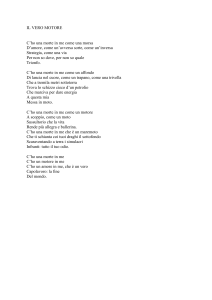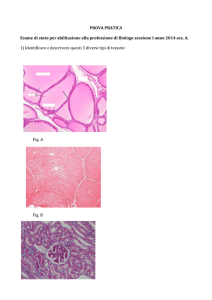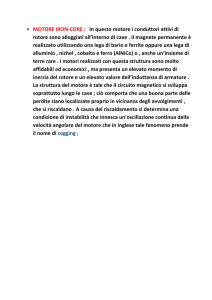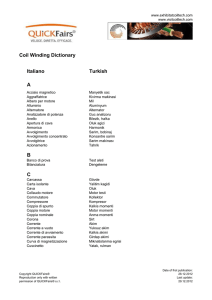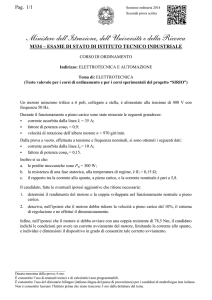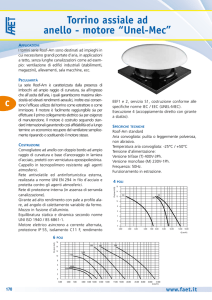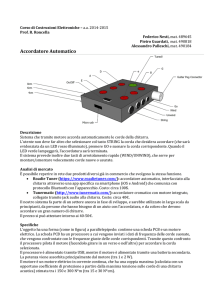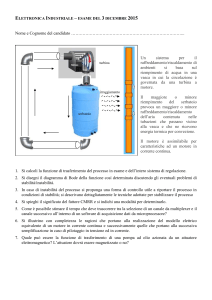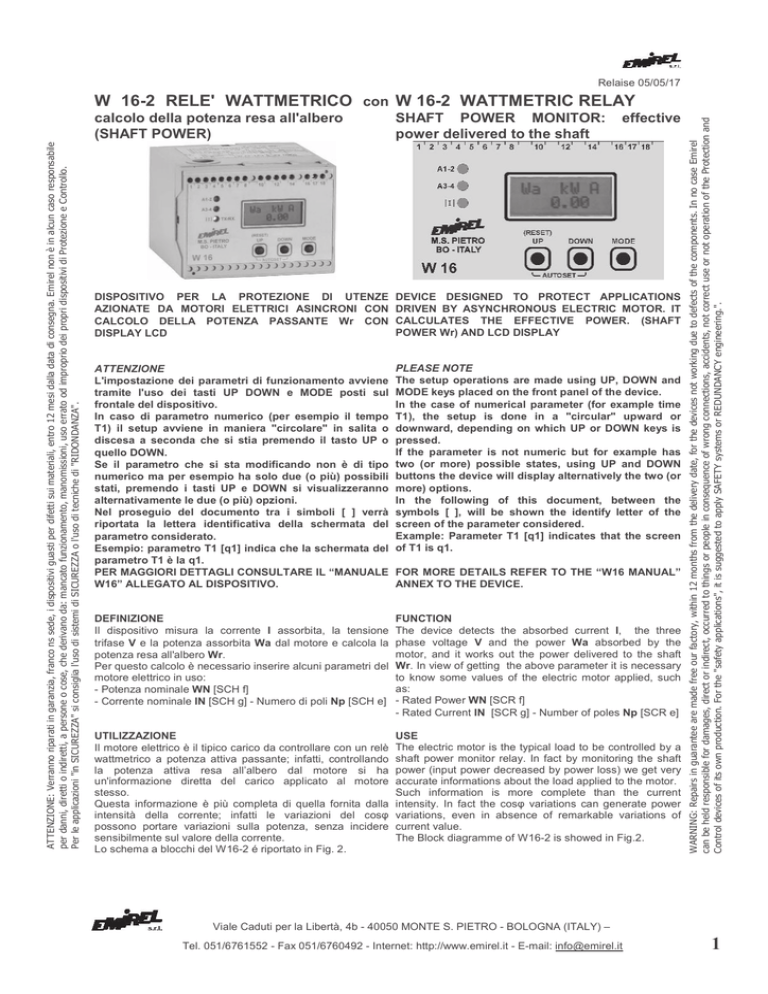
Relaise 05/05/17
calcolo della potenza resa all'albero
(SHAFT POWER)
SHAFT POWER MONITOR:
power delivered to the shaft
effective
DISPOSITIVO PER LA PROTEZIONE DI UTENZE
AZIONATE DA MOTORI ELETTRICI ASINCRONI CON
CALCOLO DELLA POTENZA PASSANTE Wr CON
DISPLAY LCD
DEVICE DESIGNED TO PROTECT APPLICATIONS
DRIVEN BY ASYNCHRONOUS ELECTRIC MOTOR. IT
CALCULATES THE EFFECTIVE POWER. (SHAFT
POWER Wr) AND LCD DISPLAY
ATTENZIONE
L'impostazione dei parametri di funzionamento avviene
tramite l'uso dei tasti UP DOWN e MODE posti sul
frontale del dispositivo.
In caso di parametro numerico (per esempio il tempo
T1) il setup avviene in maniera "circolare" in salita o
discesa a seconda che si stia premendo il tasto UP o
quello DOWN.
Se il parametro che si sta modificando non è di tipo
numerico ma per esempio ha solo due (o più) possibili
stati, premendo i tasti UP e DOWN si visualizzeranno
alternativamente le due (o più) opzioni.
Nel proseguio del documento tra i simboli [ ] verrà
riportata la lettera identificativa della schermata del
parametro considerato.
Esempio: parametro T1 [q1] indica che la schermata del
parametro T1 è la q1.
PER MAGGIORI DETTAGLI CONSULTARE IL “MANUALE
W16” ALLEGATO AL DISPOSITIVO.
PLEASE NOTE
The setup operations are made using UP, DOWN and
MODE keys placed on the front panel of the device.
In the case of numerical parameter (for example time
T1), the setup is done in a "circular" upward or
downward, depending on which UP or DOWN keys is
pressed.
If the parameter is not numeric but for example has
two (or more) possible states, using UP and DOWN
buttons the device will display alternatively the two (or
more) options.
In the following of this document, between the
symbols [ ], will be shown the identify letter of the
screen of the parameter considered.
Example: Parameter T1 [q1] indicates that the screen
of T1 is q1.
DEFINIZIONE
Il dispositivo misura la corrente I assorbita, la tensione
trifase V e la potenza assorbita Wa dal motore e calcola la
potenza resa all'albero Wr.
Per questo calcolo è necessario inserire alcuni parametri del
motore elettrico in uso:
- Potenza nominale WN [SCH f]
- Corrente nominale IN [SCH g] - Numero di poli Np [SCH e]
FUNCTION
The device detects the absorbed current I, the three
phase voltage V and the power Wa absorbed by the
motor, and it works out the power delivered to the shaft
Wr. In view of getting the above parameter it is necessary
to know some values of the electric motor applied, such
as:
- Rated Power WN [SCR f]
- Rated Current IN [SCR g] - Number of poles Np [SCR e]
UTILIZZAZIONE
Il motore elettrico è il tipico carico da controllare con un relè
wattmetrico a potenza attiva passante; infatti, controllando
la potenza attiva resa all’albero dal motore si ha
un'informazione diretta del carico applicato al motore
stesso.
Questa informazione è più completa di quella fornita dalla
intensità della corrente; infatti le variazioni del cosφ
possono portare variazioni sulla potenza, senza incidere
sensibilmente sul valore della corrente.
Lo schema a blocchi del W16-2 é riportato in Fig. 2.
USE
The electric motor is the typical load to be controlled by a
shaft power monitor relay. In fact by monitoring the shaft
power (input power decreased by power loss) we get very
accurate informations about the load applied to the motor.
Such information is more complete than the current
intensity. In fact the cosφ variations can generate power
variations, even in absence of remarkable variations of
current value.
The Block diagramme of W16-2 is showed in Fig.2.
FOR MORE DETAILS REFER TO THE “W16 MANUAL”
ANNEX TO THE DEVICE.
WARNING: Repairs in guarantee are made free our factory, within 12 months from the delivery date, for the devices not working due to defects of the components. In no case Emirel
can be held responsible for damages, direct or indirect, occurred to things or people in consequence of wrong connections, accidents, not correct use or not operation of the Protection and
Control devices of its own production. For the "safety applications", it is suggested to apply SAFETY systems or REDUNDANCY engineering.".
ATTENZIONE: Verranno riparati in garanzia, franco ns sede, i dispositivi guasti per difetti sui materiali, entro 12 mesi dalla data di consegna. Emirel non è in alcun caso responsabile
per danni, diretti o indiretti, a persone o cose, che derivano da: mancato funzionamento, manomissioni, uso errato od improprio dei propri dispositivi di Protezione e Controllo.
Per le applicazioni "in SICUREZZA" si consiglia l'uso di sistemi di SICUREZZA o l'uso di tecniche di "RIDONDANZA".
W 16-2 RELE' WATTMETRICO con W 16-2 WATTMETRIC RELAY
Viale Caduti per la Libertà, 4b - 40050 MONTE S. PIETRO - BOLOGNA (ITALY) –
Tel. 051/6761552 - Fax 051/6760492 - Internet: http://www.emirel.it - E-mail: [email protected]
1
CARATTERISTICHE E REGOLAZIONI
Tutti i parametri di funzionamento sono impostabili mediante
i pulsanti UP, DOWN e MODE presenti sul pannello frontale
del dispositivo. Il pulsante di UP ha funzione di RESET solo
nella schermata A.
CHARACTERISTICS AND REGULATIONS
All the working values are set by the UP, DOWN and
MODE push buttons located on the device front panel.
The UP push button, only in the screen “A”, works as
RESET.
S1, S2 (s2), S3, S4 (s4) (v. Fig.3) [SCH j÷p]
Il dispositivo è dotato di quattro soglie di intervento (visibili
sul display LCD) impostabili con i tasti UP e DOWN, S1 ed
S3 sono soglie di MAX, S2 (s2) ed S4 (s4) possono essere
di min (s) o di MAX (S) a seconda della necessità.
Le soglie S1 ed S2 (s2) sono collegate al relè A.
Le soglie S3 ed S4 (s4) sono collegate al relè B.
L’intervento del relè A è ritardato del tempo T1 (S1) o del
tempo T2 (S2 o s2).
Il relè B non è ritardato.
S1, S2 (s2), S3, S4 (s4) (see Fig.3) [SCR j÷p]
The device is equipped with four set points (shown on the
front display). The set points are set by the UP and DOWN
push buttons. S1 and S3 are MAX set points, while S2
(s2) and S4 (s4) can be set as MAX or min set points, on
request.
The set points S1 and S2 (s2) are connected to the relay
A.
The set points S3 and S4 (s4) are connected to the relay
B.
The relay A is dalayed by time T1 (S1) or by time T2 (S2
or s2). The relay B is not delayed.
T1 [SCH q1]
Temporizzazione regolabile da 0 a 120sec.
Ritarda l'intervento del relè di allarme quando avviene il
supero della soglia S1.
T2 [SCH q2]
Temporizzazione regolabile da 0 a 120sec.
Ritarda l'intervento del relè di allarme quando avviene il
supero della soglia S2 (s2).
Tc (Tempo di cecità) [SCH q3]
Temporizzazione regolabile da 0 a 120sec.
Esclude l'intervento di tutte le soglie di allarme per
permettere di superare lo spunto di potenza del motore.
Questo timer si attiva quando la corrente assorbita dal
carico supera la soglia interna posta a 1/10 del fondo scala
FS scelto.
Il supero delle soglie S1 ed S2 (s2) è segnalato
dall’accensione del led A1-2. Contemporaneamente sul
display apparirà il messaggio AL1 (supero di soglia S1) o
AL2 (supero di soglia S2). Dopo il tempo T1 o T2 il relè A
cambierà di stato.
Il supero delle soglie S3 ed S4 (s4) è segnalato
dall'accensione del led A3-4 (supero di soglia S3 e supero
di soglia S4).
Contemporaneamente sul display apparirà il messaggio
AL3 (supero di soglia S3) o AL4 (supero di soglia S4) e il
relè B cambierà di stato.
L’allarme può essere a ripristino manuale o automatico.
RRTA (v. TAB. A) [SCH a]
E’ variabile da 1 a 150.
Il parametro RRTA è il rapporto tra la corrente del primario
Ip e la corrente Is del secondario del TA esterno che può
essere necessario collegare (chiudendo il suo secondario
entro il TA del W16).
In caso di inserzione diretta, RRTA=1.
Agendo sui pulsanti UP o DOWN sarà possibile impostare il
valore desiderato.
Per maggiore chiarezza circa l'impostazione del valore del
parametro RRTA consultare la tabella A.
T1 [SCR q1]
Timer adjustable from 0 to 120 sec.
It delays the relay alarm triggering when the set point S1 is
overcome.
T2 [SCR q2]
Timer adjustable from 0 to 120sec.
It delays the relay alarm triggering when the set point S2
(s2) is overcome.
Tc (Initial timer) [SCR q3]
Timer adjustable from 0 to 120sec.
It excludes the set point triggerings for enabling to pass
the motor start up spikes. The timer is active when the
current in the load overcome the internal set point set at
1/10 of the full scale FS selected.
The Led A1-2 lights when the set point S1 and S2 (s2) are
overcome, at the same time the display will show the
message AL1 (set point S1 overcome) or AL2 overcome
(set point S2 overcome).
After the time delay T1 or T2 the relay A changes over.
The Led A3-4 light when the set point S3 and S4 (s4) are
overcome. At the same time the display will show the
message AL3 (set point S3 overcome) or AL4 (set point
S4 overcome) and the relay B changes over.
The alarm can have manually or automatically reset.
RRTA (v. TAB. A) [SCR a]
Adjustable form 1 to 150.
The value RRTA is the ratio between the current in the
primary IP and the curresnt Is of the secondary of the
external CT that may be required to connect to the internal
CT of W16. In case of direct insertion RRTA=1
The required ratio is set by pressing the UP or DOWN
push buttons.
For better guidance in setting the value of RRTA, follow
up the indications of the table TAB.A.
Viale Caduti per la Libertà, 4b - 40050 MONTE S. PIETRO - BOLOGNA (ITALY) –
2
Tel. 051/6761552 - Fax 051/6760492 - Internet: http://www.emirel.it - E-mail: [email protected]
TAB. A
W 16
VD=400 Vac
WN
(kW)
IN (A)
n
TA est.
Ext. CT
RRTA
N
FS(A)
Uscita analogica
Wa THEOR.
Analog output
(kW)
1V ® x,x kW
0,37
1,1
-
-
1
10
15
0,76
1V ® 0,08
0,55
1,5
-
-
1
9
15
1,04
1V ® 0,1
0,75
1,9
-
-
1
7
15
1,32
1V ® 0,13
1,1
2,6
-
-
1
5
15
1,8
1V ® 0,18
1,5
3,6
-
-
1
4
15
2,5
1V ® 0,25
2,2
5
-
-
1
3
15
3,5
1V ® 0,35
3
6,6
-
-
1
2
15
4,6
1V ® 0,46
4
8,5
-
-
1
1
15
5,9
1V ® 0,59
5,5
11,3
-
-
1
1
15
7,8
1V ® 0,78
7,5
15,2
-
-
1
1
15
10,5
1V ® 1,05
11
21,7
-
-
1
1
25
15
1V ® 1,5
15
29,3
-
-
1
1
40
20,3
1V ® 2,0
18,5
36
-
-
1
1
40
25
1V ® 2,5
22
41
-
-
1
1
40
28,4
1V ® 2,8
27
55
-
-
1
1
60
38,1
1V ® 3,8
30
68
-
-
1
1
80
47,1
1V ® 4,7
37
81
-
-
1
1
80
56,1
1V ® 5,6
45
99
1
100/5
20
3
15
68,6
1V ® 6,9
45
99
2
200/5
20
3
15
68,6
1V ® 6,9
55
110
1
150/5
30
3
15
76,2
1V ® 7,6
55
110
2
300/5
30
3
15
76,2
1V ® 7,6
...
...
..
...
...
..
...
...
...
110
200
1
200/5
40
3
15
138,6
1V ®13,9
110
200
2
400/5
40
3
15
138,6
1V ® 13,9
...
...
..
...
...
..
...
...
...
355
700
1
750/5
150
3
15
485
1V ® 48,5
Legenda TAB. A
FS = Fondo Scala selezionato
del W16 (15-25-40-6080A) [SCH c]
TA = Riduttore di corrente.
RRTA = parametro da inserire
nel W16 RRTA=Ip/Is
N = numero di passaggi del
filo del secondario del TA
esterno entro il foro del
W16.
n = numero di passaggi della
fase amperometrica nel
foro del TA esterno.
Legend TAB. A
FS = Current full scale of the
W16
(15-25-40-6080A) [SCR c]
CT = Current Transformer
RRTA = parameter to be
entered in the W16
RRTA=Ip/Is
N = number of wirings of the
Secondary of the external
CT through the hole of
the W 16.
n = number of wirings of the
amperemetric phase
through the hole of the
external CT.
Fig. 3
VISUALIZZAZIONI
VISUALIZATIONS
LED
- Led A1-2 rosso di superamento delle soglie S1 ed S2.
- Led A3-4 rosso di superamento delle soglie s3 e s4.
- Led blu |I| con due diverse funzioni:
1) acceso fisso indica la necessità di cambiare portata.
2) singolo flash di 1 sec accompagnato dalla scritta
MEM sul display segnala la memorizzazione di un
parametro.
LED
- Led A1-2 red shows when set points S1 and S2 are
overcome.
- Led A3-4 red shows when set points s3 and s4 are
overcome.
- Led |I| (blue) with two different functions:
1) steady light it signals the need to change the input
range
2) 1 sec flash appears followed by the writing MEM on
the display it signals the storage of a functioning
parameter.
DISPLAY LCD 2x8 back-lighted.
- Instant active power absorbed by the motor Wa (kW)
- Shaft power (effective power available on the motor
shaft) Wr (kW)
- Current I and line voltage V
- Set values (timers and set points)
- Alarm messages AL1, AL2, AL3, AL4 referred to set
points S1, S2 (s2), S3, S4 (s4).
DISPLAY LCD 2x8 RETROILLUMINATO
- Potenza attiva istantanea assorbita dal motore Wa (kW)
- Potenza passante resa all'albero motore Wr (kW)
- Corrente assorbita I e tensione di linea V
- Parametri di impostazione (tempi e soglie)
- Messaggi di allarme AL1, AL2, AL3, AL4 di supero delle
soglie S1, S2 (s2), S3, S4 (s4).
FUNZIONAMENTO
Il grafico di Fig. 4 illustra il funzionamento del W 16 in
funzione del valore delle soglie, indipendentemente dal fatto
che siano state impostate manualmente o tramite
AUTOSET.
MODE OF OPERATION
The diagramme in Fig. 4 shows the W 16 operation basing
on the set points, no matter if they have been set manually
or with the autoset function.
In caso di funzionamento standard le soglie di intervento In the standard mode of operation the set points
Viale Caduti per la Libertà, 4b - 40050 MONTE S. PIETRO - BOLOGNA (ITALY) –
Tel. 051/6761552 - Fax 051/6760492 - Internet: http://www.emirel.it - E-mail: [email protected]
3
S1, s2, S3, s4 are
manually set and the
values of SA1, SA2,SA3,
SA4 are not considered
(s2 and s4 in this case
are minimum set points
because they are
identified by a little letters
make ref to the details in
the shot screen “I” and
“p”.)
S1,s2,S3,s4 saranno
state impostate manualmente ed i valori dei
parametri SA1, SA2,
SA3, SA4 non saranno
considerati. (s2 ed
s4 in questo caso
sono soglie di intervento di minima, perché
indicate con la lettera
minuscola - per dettagli
vedere descrizione
schermate "l" e "p").
In caso di funzionamento AUTOSET
SA1, SA2, SA3, SA4
[SCH u1÷u4] saranno
utilizzati per il calcolo
delle soglie di intervento secondo quanto
illustrato nella Tab. B.
In the AUTOSET mode of
operation the values of
SA1, SA2, SA3, SA4
[SCR u1÷u4] are used
for the calculation of the
triggering set points,
according to the
Table B.
Fig. 4
FUNZIONAMENTO (in modalità STANDARD)
Il W16 mediante il calcolo della potenza passante permette
un controllo più preciso del carico di un motore.
Il dispositivo W16 esegue la rilevazione e la visualizzazione
della potenza attiva e calcola e visualizza la potenza
passante Wr (nella quale le perdite del motore non sono
presenti). L’informazione data dalla potenza passante é più
completa dell’informazione data dalla sola corrente in
quanto tiene conto delle variazioni di cosj.
L’utilizzo della potenza Wr (potenza resa all’albero o
potenza passante) permette un controllo del carico più
accurato rispetto ai relè wattmetrici che utilizzano solo
la potenza assorbita dalla rete Wa.
All'accensione del motore il "picco" di potenza viene
ignorato mediante l'uso del TC.
A regime, l'intervento delle soglie S1 ed S2 (s2) è ritardato,
indipendentemente, con T1 e T2 (v. Fig.3). In caso di
funzionamento in modalità AUTO-APPRENDIMENTO,
l'impostazione dei valori di S1,S2 (s2), S3, S4 (s4) sarà
automatica. (Vedere modalità AUTO-APPRENDIMENTO).
Lo strumento resta programmato anche togliendo
l'alimentazione.
FUNZIONAMENTO (in modalità AUTOSET)
Nel funzionamento autoset le soglie non vengono impostate
dall'utente ma vengono calcolate dal dispositivo una volta
raggiunta la condizione di funzionamento a regime
desiderato. L'utente dovrà solo aver impostato gli
scostamenti percentuali SA1, SA2, SA3, SA4 desiderati
rispetto al valore di Wm (potenza resa a regime nel
momento dell’Autoset). Il W16 in modalità autoapprendimento segue questo ciclo di funzionamento: il
motore viene alimentato e caricato.
Per entrare nella procedura AUTOSET portarsi nella
schermata "A" e, in condizione di funzionamento del motore
non
in
allarme,
premere
(e
tenere
premuti)
contemporaneamente i tasti UP+DOWN. Comparirà il
messaggio AUTOSET, quindi rilasciare i pulsanti.
Per indicare il funzionamento in AUTOSET nella schermata
"A" vicino a "Wa" comparirà il simbolo “■”.
PARAMETRO / PARAMETER
SA1,SA2,SA3,SA4
scostamento percentuale
=
SA1,SA2,SA3,SA4 = percentage
variation
Esempio / Example:
SA1=20%
S1=Wm+0,2xWm
STANDARD MODE OF OPERATION
The device W16 performs an accurate control of the motor
load by calculating the shaft power. W16 measure and
displays the active power and calculates and displays the
effective power Wr (where the motor power losses are not
present). The information given by the motor shaft power
is more complete than the information given by the current
because also the cosφ variations are considered.
Using the power shaft motor Wr assures, mainly in the
more difficult cases, a more reliable load supervision
than the usual wattmetric relays that use the active
power Wa.
At the motor start up the power spike is covered by the
initial timer TC.
During the regular operation the triggering of set points S1
and S2 (s2) is delayed with T1 and T2 respectively (v.
Fig.3)
In case of autoset mode of operation, the values S1,S2
(s2), S3, S4 (s4) are set automatically. (See autoset
mode).
Also after the voltage supply is cut off the device remain
programmed.
AUTOSET MODE OF OPERATION
In the autoset mode of operation the set points are not set
by the operator, but they are set by the device once it
reaches the desired operating conditions.
The operator shall have to set only the percentage
variations SA1, SA2, SA3, SA4 respect of Wm, (shaft
power in running condition).
W 16 in autoset mode of operation follows this working
cycle:
The motor is supplied.
In order to enter in the AUTOSET procedure move to the
"A shot screen" and, during the normally working of the
motor, press both UP and DOWN push bottons until the
messagge "AUTOSET" will not appear on the display.
In order to indicate the AUTOSET working mode in the
screen shot "A" will appear the symbol “■”.
DESCRIZIONE
Parametri impostabili indipendentemente l'uno
dall'altro.
Variabili tra Ø e 99% del valore di Wm (a
regime).
Vengono calcolate le soglie di allarme S1,S2
(s2),S3,S4 (s4) :
S1 = Wm + SA1
S2 = Wm + SA2 (S2 soglia di MAX)
s2 = Wm - SA2 (s2 soglia di Min)
S3 = Wm + SA3
S4 = Wm + SA4 (S4 soglia di MAX)
s4 = Wm - SA4 (s4 soglia di Min)
DESCRIPTION
These parameters can be set separately from
Ø to 99% of the Wm value after the start up.
With these values the device set the alarm set
points S1, S2 (s2), S3, S4 (s4):
S1 = Wm + SA1
S2 = Wm + SA2 (S2 MAX set point)
s2 = Wm - SA2 (s2 Min set point)
S3 = Wm + SA3
S4 = Wm + SA4 (S4 MAX set point)
s4 = Wm - SA4 (s4 Min set point)
Viale Caduti per la Libertà, 4b - 40050 MONTE S. PIETRO - BOLOGNA (ITALY) –
4
Tel. 051/6761552 - Fax 051/6760492 - Internet: http://www.emirel.it - E-mail: [email protected]
TARATURA (in modalità STANDARD)
SETTING (in standard mode operation)
SET POINT S1, S2 (s2) [SCH j÷n]
Portare S1 e TC al massimo, T1, T2 al minimo e S2 al
massimo se è programmata di MAX, a zero se è
programmata di min. Con il motore acceso e
opportunamente "caricato", abbassare la regolazione della
soglia S1 fino ad avere l'accensione del led A1-2 e
l'intervento del dispositivo. A questo valore di soglia si
dovranno applicare delle correzioni che tengano conto delle
condizioni operative finali della macchina, della temperatura,
dell'invecchiamento ecc... ecc...
Spegnere il motore e riaccendere varie volte, riducendo ogni
volta il TC fino a trovare il valore per cui si ha subito
l'intervento.
A questo valore si dovranno apportare delle correzioni per le
stesse considerazioni fatte per la soglia S1.
Aumentare opportunamente il T1 per evitare interventi
intempestivi durante il funzionamento normale.
Se la soglia S2 è programmata di MAX, si dovrà seguire la
stessa procedura seguita per la soglia S1.
Se la soglia s2 è programmata di min: accendere il motore
“senza carico”, aumentare la regolazione della soglia s2 da
zero fino all’accensione del led A1-2; a questo valore
applicare delle correzioni per le considerazioni sopraddette.
Aumentare opportunamente T2.
S1, S2 (s2) SET POINTS [SCR j÷n]
Set S1 and TC to the maximum, T1 and T2 to the
minimum; S2 to the maximum if it is set as maximum set
point, to zero (s2) if it is set as minimum set point (TC is
active or not depending on the applications).
With motor supplied and opportunely loaded, lower the S1
value until the led A1-2 lights on.
The reached value has to be rectified conveniently in order
to consider the age of the machine, the temperature and
working conditions etc.
Stop the motor and start it up again several times
gradually reducing each time the initial timer TC until
reaching the value where the device triggers promptly.
This value shall have to be rectified conveniently for the
same reasons explained above for S1.
Timer T1 shall have to be increased for avoiding wrong
alarms during regular operation.
If S2 is set as max set point, follow the same setting
procedure adopted for S1.
If s2 is set as min set point, the following procedure must
be adopted.
Start up the motor without load; increase the s2 set point
regulation until the led A1-2 lights on.
Increase opportunely the Timer T2.
SET POINT S3 e S4 (s4) [SCH o,p]
Portare S3 e S4 al massimo se è programmata di MAX, a
zero se è programmata di min.
Con il motore acceso e "caricato", abbassare la regolazione
della soglia S3 fino ad avere l'accensione del led A3-4 e
l'intervento del dispositivo. A questo valore di soglia si
dovranno applicare delle correzioni che tengano conto delle
condizioni operative finali della macchina, della temperatura,
dell'invecchiamento ecc...ecc... Se la soglia S4 è
programmata di MAX, si dovrà seguire la stessa procedura
seguita per la soglia S3. Se la soglia s4 è programmata di
min seguire la seguente procedura: accendere il motore con
"senza carico", aumentare la regolazione della soglia s4 fino
all’accensione del led A3-4; a questo valore applicare delle
correzioni per le considerazioni sopraddette.
E’ consigliato verificare tutti gli allarmi di MAX e di Min per il
corretto funzionamento del sistema.
S3, S4 (s4) SET POINTS [SCR o,p]
Set S3 to the maximum, S4 to the maximum if it is set as
maximum set point, to zero (s4) if it is set as minimum set
point (TC is active or not depending on the applications).
With motor on opportunely loaded, lower the S3 value until
the led A3-4 lights on. The reached value has to be
rectified conveniently in order to consider the age of the
machine, the temperature and working conditions etc. If
S4 is set as max set point, follow the same setting
procedure adopted for S3.
If s4 is set as min set point follow the following procedure:
Start up the motor without load; increase the s4 set point
regulation until the led A3-4 lights.
Rectify the reached point for the reasons above explained.
It is suggested to simulate overload and underload
conditions, to verify the correct setting operation.
RIPRISTINO [SCH k,n]
Le soglie di allarme S1 ed S2 (s2) sono impostati per
default a ripristino automatico.
Nelle schermate sopra indicate possono essere impostate a
ripristino manuale, indipendentemente l'una dall'altra,
scegliendo l’opzione “man”.
In questo caso, il ripristino avviene premendo il tasto UP
(RESET) quando la condizione di allarme viene a cessare (il
pulsante di reset è attivo solo nella schermata “A”) o usando
un contatto esterno collegato ai pin 18-19.
Le soglie S3 ed S4 (s4) sono solo a ripristino automatico.
USCITE A RELE’ [SCH t1-t2]
I due relè interni RA e RB sono per default “normalmente
ON” (i contatti di riposo sono chiusi) e andranno OFF in
caso di allarme. I due relè possono essere singolarmente
programmati “normalmente OFF” e andranno ON in caso di
allarme.
USCITA ANALOGICA [SCH s]
Ai pin 17-18 (+ sul pin 17) è disponibile una tensione 0-10
Vdc fondo scala (max 1mA) proporzionale alla potenza
attiva istantanea Wa assorbita o alla potenza resa Wr
calcolata dal W16.
Si consiglia di utilizzare un VOLTMETRO DC DVD 08, con
possibilità di calibratura, per poter visualizzare "100" o il
valore che si legge sul display del W16 in condizione di
normale funzionamento (schermata A).
RESET [SCR k,n]
The set points S1 and S2 (s2) are set by default with
automatic reset.
These can be programmed in manual mode independently
one from each other selecting “man”.
In this case the reset takes place by pressing the UP
(RESET) push-button when the alarm condition stops (the
reset key is active only in the “A” screen) or by using an
external contact connected to pins 18-19.
The set points S3 and S4 (s4) are only with automatic
reset.
RELAY OUTPUT [SCR t1-t2]
The two internal relays RA and RB are, by default,
“normally ON” (the NC contacts are closed) and they will
go “OFF” in case of alarm. The two relays can be
individually programmed “normally OFF” and they will go
“ON” in case of alarm.
ANALOG OUTPUT [SCR s]
At the pins 17-18 (+ on pin 17) the voltage 0-10Vdc full
scale (max 1mA) is available.
The 0-10 Vdc signal is proportional to the instant active
power Wa measured or to the shaft power Wr calculated
by W16 depending of the value of the related parameter in
the set screen. It is suggested to apply a DC VOLTMETER
DVD 08, with calibration of the reading, in order to display
"100" or the value appearing on the display of W 16 during
normal operation (“A” screen).
Viale Caduti per la Libertà, 4b - 40050 MONTE S. PIETRO - BOLOGNA (ITALY) –
Tel. 051/6761552 - Fax 051/6760492 - Internet: http://www.emirel.it - E-mail: [email protected]
5
COLLEGAMENTI ELETTRICI
Collegamenti a vite sul frontale da eseguire secondo schemi
di fig. 5-6 (motore trifase) o fig.7 (motore monofase). Per la
scelta del TA vedere il paragrafo inerente il parametro
RRTA.
(Collegamento a un quadro elettrico con differenziale e
sezionatore). La lunghezza di ogni collegamento deve
essere < 30m.
WIRING DIAGRAMS
Screw connections on the front to be made as per fig. 5-6
(three-phase motor) or fig. 7 (single phase motor).
For the CT's selection see the paragraph referring to the
parameter RRTA.
(Wiring to an electrical board with a differential relay and a
sectionalizing switch). The lenght of every wiring must be
less than 30m.
ESEMPI DI COLLEGAMENTI
1. TRIFASE IN < 80A : inserzione diretta
Seguire lo schema di fig.5
pin voltmetrici: 15-13-11
2. TRIFASE IN > 80A : con TA.. /5
Seguire lo schema di fig. 6
pin voltmetrici: 15-13-11
3. MONOFASE IN<80A : Inserzione diretta
Seguire lo schema di Fig.7
pin voltmetrici: 15-11 (pin 13 collegato ai pin 15)
EXAMPLES OF CONNECTIONS
1. THREEPHASE IN< 80A: direct insertion
Follow diagramme of fig. 5
Voltage pins : 15-13-11
2. THREEPHASE IN > 80A : Connection by CT ../5
Follow diagramme of fig.6
Voltage pins : 15-13-11
3. SINGLE PHASE IN < 80A: Direct insertion
Follow diagramme of Fig.7
Voltage pins: 15-11 (pin 13 connected to pin 15)
NOTA 3: La fase di cui si misura la corrente (fase REMARK 3:
amperometrica, nelle figure 5,6 e 7 è la L1) deve essere The phase carring the measured current (amperometric
collegata all'ingresso voltmetrico 15.
phase L1) must be connected to voltage pin 15.
Per utilizzare correttamente un W16 occorre determinare i
seguenti quattro elementi del motore: [vedere targa motore]
1) Tensione di alimentazione del motore (400 Vac ecc.)
2) Potenza nominale del motore WN
3) Corrente di targa del motore IN
4) Numero di poli del motore Np
For a correct application of the W16 the four following
motor elements must be correctly identified: [see the
motor plate]
1) Motor Voltage (400 Vac etc)
2) Rated power WN
3) Rated current IN
4) Number of poles of the motor Np
INGRESSI
Ring = 800 kW
PIN Voltmetrici: 15-13-11 (Vedere Nota 3).
Massima tensione trifase 415 Vac.
Per tensioni maggiori di 400 Vac è necessario usare M 08:
resistenza di caduta trifase (Ved. Fig. 8).
Corrente di misura: diretta fino a 80A, per correnti superiori
è necessario un TA esterno .../5 (ved. TAB. C).
INPUTS
Input Resistance=800 kW
Voltage pins: 15-13-11. (See Remark 1).
Maximum threephase voltage is 415 Vac.
For higher voltages is requested the application of M 08:
Threephase drop resistances (see Fig. 8).
Current range: direct up to 80A, With external CT .../5 for
current higher than 80A (see TAB. C).
Viale Caduti per la Libertà, 4b - 40050 MONTE S. PIETRO - BOLOGNA (ITALY) –
6
Tel. 051/6761552 - Fax 051/6760492 - Internet: http://www.emirel.it - E-mail: [email protected]
USCITE
RELE’ 5A (NA) 230 Vac, carico resistivo
“a1” 8-9 NA
8-7 NC Dispositivo non
“a2” 5-6 NA
alimentato
5-4 NC
OUTPUTS
RELAYS 5A (NA) 230 Vac, resistive load
a1” 8-9 NO
8-7 NC
Device not
“a2” 5-6 NO
supplied
5-4 NC
ALIMENTAZIONE: 230 Vac o 24 Vac
monotensione 6VA 50-60Hz ±10% pin 1-2
DIMENSIONI: 100x70x110 mm x GUIDA DIN.
TEMPERATURA DI FUNZIONAMENTO: 0÷70°C
PESO: Kg 0,550
COLORE: grigio
SUPPLY: 230 Vac or 24 Vac
Single voltage 6VA 50-60 Hz ±10% -pin 1-2
DIMENSIONS: 100x70x110 mm Din Rail
WORKING TEMPERATURE: 0÷70°C
WEIGHT: Kg 0,550
COLOUR: grey
NOTA IMPORTANTE
Si consiglia di non posizionare, in prossimità del W16 e dei
suoi cavi di collegamento, dei dispositivi che possano creare
disturbi come teleruttori, inverter ecc... I teleruttori è
opportuno vengano sempre dotati degli appositi snubber
(collegati alla bobina del teleruttore).
IMPORTANT NOTE
Please do not place close to the W16 and its connection
cables some devices that might create disturbances such
as contactors, inverters and so on...
The contactors should be equipped with appropriate
snubber (on the contactor coil).
MISURE DI SICUREZZA
Il dispositivo DEVE essere installato esclusivamente
all’interno di un quadro elettrico chiuso mediante chiave o
dispositivo analogo.
L’accesso al suddetto quadro e di conseguenza al
dispositivo DEVE essere effettuato esclusivamente a
quadro disalimentato e SOLO dal personale di
manutenzione o di installazione opportunatamente formato
ed addestrato alla operazione prevista.
SECURITY MEASURES
The device MUST be installed only inside a electrical
panel closed by a key or similar device.
Access to this electrical panel and consequently at the
device MUST be done exclusively with panel switched off
and ONLY by maintenance or installation personnel
suitably formed and trained for the planned operation.
Per la pulizia usare un panno imbevuto di detergenti privi di: For cleaning use a cloth soaked with detergents without:
Alcool denaturato, Benzene, Alcool isopropilico.
Denatured Alcohol, Benzene, Isopropyl alcohol.
TAB. C
MODELL
O
MODEL
E 647A
E 647B
E 647C
E 647D
E 647E
E 647F
E 647G
TA Esterni / External CT
TIPO
TYPE
TC 22
TC 22
TC 40
TC 40
TC 40
TC 40
TC 50
(A)
CORRENTE
SECONDARIO
SECONDARY
CURRENT
PRESTAZIONE
BURDEN
CLASSE
CLASS
150
250
300
400
500
800
1000
5A
5A
5A
5A
5A
5A
5A
5VA
10VA
8VA
10VA
12VA
20VA
30VA
0,5
0,5
0,5
0,5
0,5
0,5
0,5
GAMMA
RANGE
COMPATIBILITA' ELETTRO
MAGNETICA
Electromagnetic compatibility
CEI-EN 61326-1
“BASSA TENSIONE” - LVD
LVD – “LOW VOLTAGE”
CEI-EN 61010-1
Viale Caduti per la Libertà, 4b - 40050 MONTE S. PIETRO - BOLOGNA (ITALY) –
Tel. 051/6761552 - Fax 051/6760492 - Internet: http://www.emirel.it - E-mail: [email protected]
7

